What Is a Grassland Ecosystem?

A grassland ecosystem is the collection of plants, animals and micro-organisms that live within an environment where grasses are the primary form of vegetation. Examples of grassland ecosystems include the prairies of western North America, the Pampas of Argentina and the Russian steppes.
Grasslands cover around 40 percent of the earth’s surface, and they exist in both temperate and tropical regions, generally within the dry interior areas of land masses. The amount of rainfall in grassland ecosystems is too little to support many large plants, though some trees do occur. In tropical grassland ecosystems, the heavy precipitation of the rainy season follows months of dry heat. Temperate grasslands alternate periods of abundance with periods of dormancy when the temperatures are too cold for growth.
Some grassland ecosystems, such as the savanna or the prairie, produce tall grasses. Others, such as the windy steppes, grow very short grasses often less than an inch high. Animals supported by grassland ecosystems often travel across its surface in vast herds, as with the buffalo of North America or the wildebeests of Africa. Their numbers serve as a form of defense in the wide open landscape. Others, such as prairie dogs, have adapted to life underground. Birds thrive on the seeds produced in grasslands. According to the National Audubon Society, grasslands support 47 bird species in the United States.





